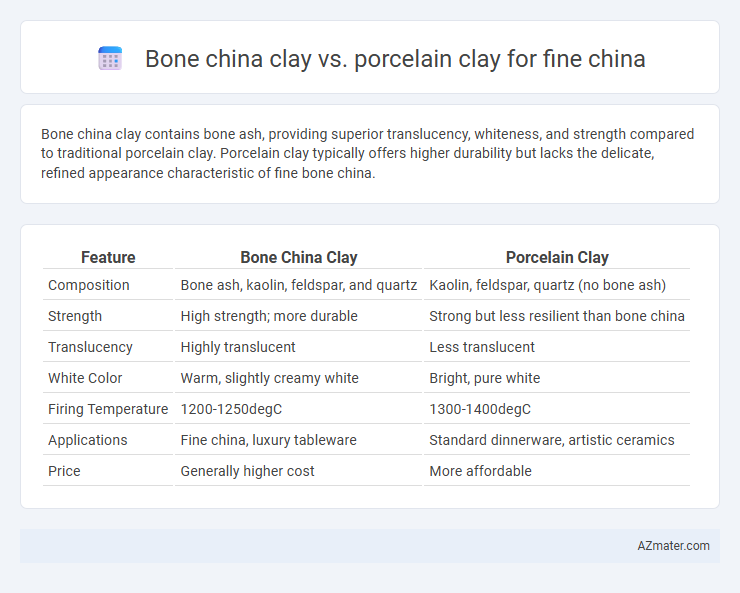Bone china clay contains bone ash, providing superior translucency, whiteness, and strength compared to traditional porcelain clay. Porcelain clay typically offers higher durability but lacks the delicate, refined appearance characteristic of fine bone china.
Table of Comparison
| Feature | Bone China Clay | Porcelain Clay |
|---|---|---|
| Composition | Bone ash, kaolin, feldspar, and quartz | Kaolin, feldspar, quartz (no bone ash) |
| Strength | High strength; more durable | Strong but less resilient than bone china |
| Translucency | Highly translucent | Less translucent |
| White Color | Warm, slightly creamy white | Bright, pure white |
| Firing Temperature | 1200-1250degC | 1300-1400degC |
| Applications | Fine china, luxury tableware | Standard dinnerware, artistic ceramics |
| Price | Generally higher cost | More affordable |
Introduction to Fine China Materials
Fine china materials primarily include bone china clay and porcelain clay, each known for their distinct characteristics in luxury tableware. Bone china clay contains bone ash, granting exceptional translucency, strength, and a warm ivory color, making it highly prized for fine china. Porcelain clay, composed mainly of kaolin, offers a pure white, durable, and dense finish but typically exhibits less translucence compared to bone china.
What is Bone China Clay?
Bone china clay is a unique blend of kaolin, feldspar, and bone ash, typically derived from calcined animal bones, which gives it remarkable whiteness, translucency, and strength compared to traditional porcelain clay. This composition results in a fine china that is lighter, more chip-resistant, and capable of achieving a delicate, glass-like finish, making it highly prized for luxury dinnerware. Bone china's distinct physical properties and smooth texture differentiate it from porcelain clay, which relies primarily on kaolin and feldspar without bone ash, resulting in a denser and less translucent ceramic.
What is Porcelain Clay?
Porcelain clay is a highly refined, white-firing ceramic material composed primarily of kaolin, feldspar, and quartz, known for its durability, translucency, and smooth surface ideal for fine china. Unlike bone china clay, which incorporates bone ash for added whiteness and strength, porcelain clay achieves its strength and whiteness purely through its mineral composition and high firing temperatures. This makes porcelain clay a preferred choice for elegant, delicate dinnerware that resists chipping and maintains a pristine appearance over time.
Key Differences Between Bone China and Porcelain
Bone china clay contains bone ash, giving it higher whiteness, translucency, and strength compared to porcelain clay, which is primarily made from kaolin. Porcelain clay fires at higher temperatures, resulting in a denser and less porous structure, while bone china's lower firing temperature preserves its delicate appearance and light weight. The key difference lies in bone china's superior chip resistance and its creamy, translucent finish versus porcelain's more opaque, durable surface.
Strength and Durability Comparison
Bone china clay exhibits superior strength and durability compared to porcelain clay due to its high bone ash content, which enhances mechanical toughness and chip resistance. Porcelain clay, although hard and slightly translucent, tends to be more brittle and prone to cracking under stress. Fine china made from bone china clay typically endures daily use better, maintaining structural integrity and a smooth finish over time.
Transparency and Whiteness
Bone china clay exhibits superior transparency and a distinctive warm whiteness due to its high bone ash content, allowing light to pass through with a delicate translucency. In contrast, porcelain clay tends to have a cooler, more opaque white finish, with less translucency due to the higher kaolin content and absence of bone ash. This difference in clay composition makes bone china highly valued for fine china requiring translucency and a creamy white appearance, while porcelain offers durability with a pure, bright white surface.
Fineness and Workability
Bone china clay contains bone ash, giving it exceptional fineness and translucency, which enhances the delicate appearance of fine china. Porcelain clay, made primarily from kaolin, offers superior workability due to its plasticity and resistance to warping during firing. The higher calcium phosphate content in bone china clay results in smoother surfaces, while porcelain clay provides a denser, more durable finish suitable for intricate designs.
Cost and Production Factors
Bone china clay, containing 25-50% bone ash, is generally more expensive than porcelain clay due to the costly raw materials and intricate processing required to achieve its translucency and strength. Porcelain clay, composed primarily of kaolin, feldspar, and quartz, offers a more economical production route with higher firing temperatures resulting in durability but less translucency. The production of bone china involves longer firing cycles and careful temperature control to preserve its delicate structure, increasing manufacturing time and overall cost compared to the faster, higher-temperature firing process of porcelain.
Ideal Uses for Bone China vs Porcelain
Bone china clay, enriched with bone ash, offers exceptional translucency and strength, making it ideal for fine dining sets, teacups, and delicate decorative pieces that require both elegance and durability. Porcelain clay, composed primarily of kaolin, suits applications demanding high thermal resistance and a smooth, white finish, such as oven-safe bakeware and intricate ceramic sculptures. Choosing bone china is preferable for refined tableware with a lightweight feel, while porcelain excels in functional items requiring sturdiness and heat tolerance.
Choosing the Best Clay for Fine China
Bone china clay contains bone ash, which enhances translucency, strength, and whiteness, making it ideal for delicate, high-quality fine china. Porcelain clay, composed mainly of kaolin, offers a denser, more vitrified, and often more durable surface suitable for both functional and decorative fine china. Choosing the best clay depends on the desired balance between delicate elegance and durability, with bone china favored for its refined translucency and porcelain prized for its robustness.

Infographic: Bone china clay vs Porcelain clay for Fine china
 azmater.com
azmater.com